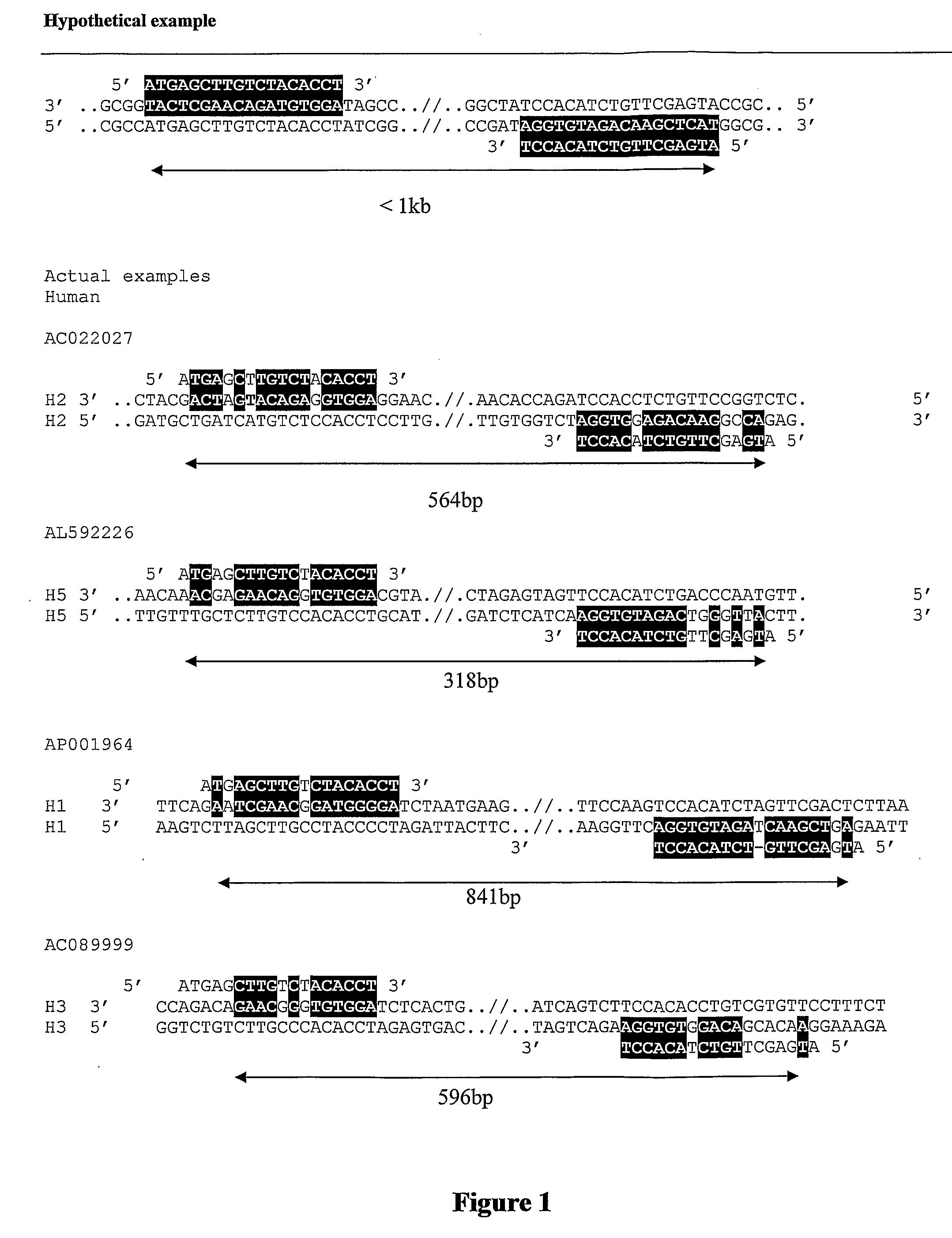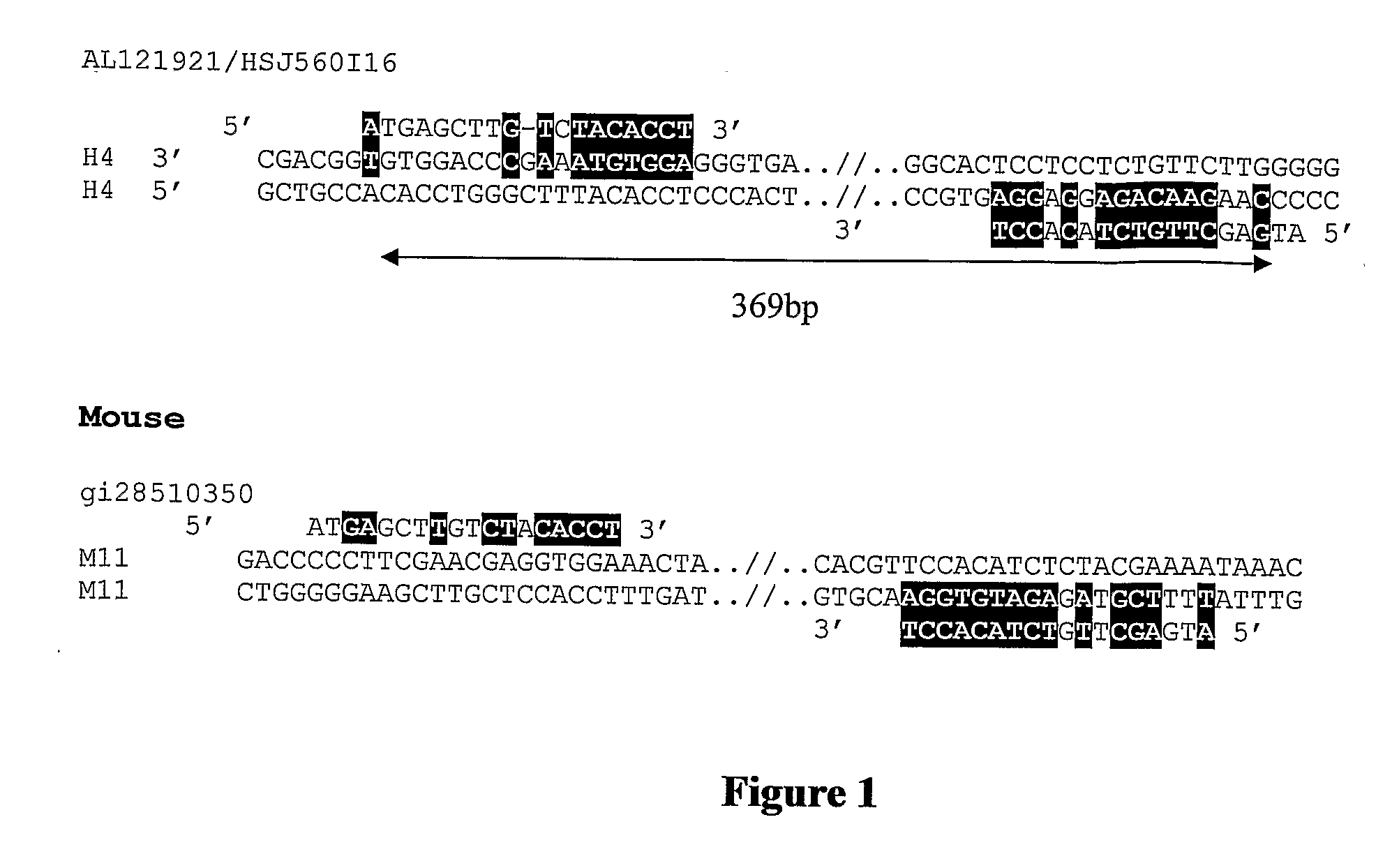Methods of genetic analysis involving the amplification of complementary duplicons
a technology of complementary duplicons and genetic analysis, applied in the field of molecular biology and genetics, can solve the problems of significant differences between individual genomes at the molecular level, deletion, insertion, inversion or translocation,
- Summary
- Abstract
- Description
- Claims
- Application Information
AI Technical Summary
Benefits of technology
Problems solved by technology
Method used
Image
Examples
example 1
Bidirectional Amplification of Complementary Duplicons Using a Primer Designed from the Fish ZP3 Gene
[0266]The zona pellucida membrane surrounding eggs contain glycoproteins, one of which, ZP3 is reported to be a receptor for sperm. Crosstaxa sperm binding is limited and is expected to be restricted by, among other things, differences in ZP3. The process of recognition and fertilization of fish eggs takes place externally and hence would need to be highly developed to ensure specificity.
[0267]ZP3 is highly variant which we predicted to be in regions with imperfect duplications. The locus and surrounding sequences from different species of fish were aligned (CLUSTALW) in order to design primers in the conserved and duplicated regions. The regions were found to contain a number of repetitive sequences. This was advantageous as it provided evidence of duplication. The preferred length of around 20mers (which was not considered to be critical) was used to select a number of primers to b...
example 2
Bidirectional Amplification of Complementary Duplicons Using Primers Designed from Human Alu Repeats
[0276]Alu repeats of the human genome where analysed for primers which could be used for BACD (FIG. 7). Two overlapping primers designated P3 (GGCACAATCGGTCCTACCAGAGCTA—SEQ ID NO: 2) and P1 (GAGATCGAGACCATCCTGGCTAACAA—SEQ ID NO: 3) were selected.
[0277]Fluorescent detection of amplified products using various DNA samples (examples include: C02 / 00470E—Horse 2, C02 / 00471L—Horse 3, C99 / 02334V Horse CR, C02 / 00391W—Donkey Polly; C02 / 00393J—Donkey Jasper; C02 / 00395X—Donkey Junior; C04 / 00485Q—Sheep C501, C04 / 00486X Sheep C502; C04 / 00487D—Sheep C503; C04 / 00488K—Sheep C504, C04 / 00489R—C505C99 / 02252D—Bull Emir, C04 / 00219T—Bull RD3, C04 / 00429M—Cow 0162, C04 / 00239D—Cow 0157, C99 / 01972K—Cow 9804, C00 / 04872N—Cow 0070, C03 / 00031B—Cow 9764, C04 / 00227Y—Cow 0428, C04 / 00496P—Great Dane 1, Dog Jemma, C04 / 00497W—Great Dane 2, C04 / 00472D Red Heeler) and primer P3 (SEQ ID NO: 2). In these examples, multiple ...
example 3
Bidirectional Amplification of Complementary Duplicons of Non-Primate Species
[0281]Interestingly, primers P1 and P3 also amplified specific and distinct bands in cattle, which were initially included as negative controls (see Example 2). As a result, the inventors analysed DNA from horse, donkeys, sheep and dogs. The amplification procedures which were used were the same as those provided above in Example 2.
[0282]Further analyses on divergent species identified species specific bands with more closely related species shared similar bands (FIGS. 15 to 18). Further, P3 identified polymorphic bands (present in some individuals of the species and not others) in cattle, dogs and the donkey.
[0283]It will be appreciated by persons skilled in the art that numerous variations and / or modifications may be made to the invention as shown in the specific embodiments without departing from the spirit or scope of the invention as broadly described. The present embodiments are, therefore, to be cons...
PUM
| Property | Measurement | Unit |
|---|---|---|
| nucleic acid sequence | aaaaa | aaaaa |
| concentration | aaaaa | aaaaa |
| sizes | aaaaa | aaaaa |
Abstract
Description
Claims
Application Information
 Login to View More
Login to View More - R&D
- Intellectual Property
- Life Sciences
- Materials
- Tech Scout
- Unparalleled Data Quality
- Higher Quality Content
- 60% Fewer Hallucinations
Browse by: Latest US Patents, China's latest patents, Technical Efficacy Thesaurus, Application Domain, Technology Topic, Popular Technical Reports.
© 2025 PatSnap. All rights reserved.Legal|Privacy policy|Modern Slavery Act Transparency Statement|Sitemap|About US| Contact US: help@patsnap.com



